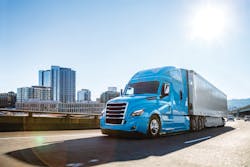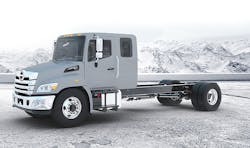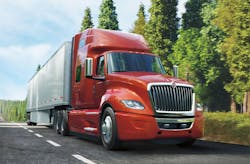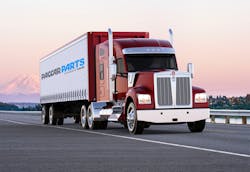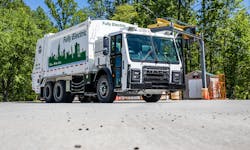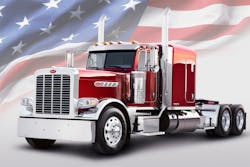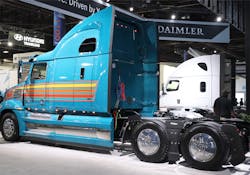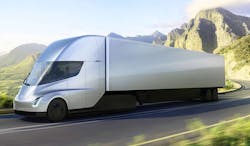While the year 2020 offloaded several challenges on the world, the trucking industry has responded to meet each one head on. As bad as things got, the general appreciation for truckers and what they do every day has been a welcome bright spot. Not to be overlooked is the way truck manufacturers have shown their gratitude to trucking fleets and individual drivers with features and amenities to make their lives easier. There were only a few groundbreaking factory-level additions for 2020, but the heavy-duty segment experienced an overall step change through an industrywide push for better safety, uptime and efficiency.
Advanced driver assistance systems (ADAS) are standard fare now and as more of these technologically advanced trucks hit the road, the less likely a brief moment of inattention by the driver or a reckless passenger car loitering in a blind spot will lead to an accident. Instead, the collaboration between sensors, driver and braking, and even steering systems will mitigate and even prevent crashes.
On the uptime side, over-the-air updates, which can improve systems and sense problems before an issue turns critical, have been embraced by OEMs. And more savvy spec’ing of new builds is now possible due to a larger offering of specific powertrain packages and à la carte add-ons to help customers find the right balance between performance and efficiency.
And while we hope to put 2020 in the rearview mirror, 2021 may be the year celebrated in perpetuity by future generations, for it will mark the emergence of zero-emission trucks, which will finally be rolling off production lines next year. The impact of these new trucks on global emissions will not be immediately felt, but their reduction on total cost of ownership due to fewer moving parts and less maintenance, along with improvements to drivability, should convert more diesel diehards into battery-electric believers by 2022.
Here are the updates each truck maker has recently made, or is planning to make, for Classes 7 and 8.
Freightliner:
In 2020, Freightliner Cascadia customers got their first experience using Daimler’s Detroit Assurance 5.0 safety suite. The technology provides SAE Level 2 automation, as well as providing up to 5% fuel efficiency gains. Fleets looking to place builds in 2021 should keep in mind this requires spec’ing a Detroit powertrain. Wheel covers also come standard to improve aerodynamics and bump those gains up even more.
Come January 2021, Cascadias can also house the “significantly redesigned” DD15 Gen 5, which provides even more efficient fuel consumption and emissions reduction. Users can expect 3% better fuel economy from the inline 6-cylinder engine through the combination of ultra-high compression ratios and a swirl piston design. More versatile power ratings, along with an improved turbocharger to reach peak performance quicker and aftertreatment tweak to shorten regen cycles, round out the key features.
The battery-electric eCascadia, which has been tested by a few fleets, will see a major ramp up in 2021, with the goal of full production by 2022. The eCascadia has a gross vehicle weight rating (GVWR) of 80,000 lbs. and a 730 peak hp. Optimal for short hauls, the zero-emission truck has a range of 250 miles and, after a 90-minute fast charge, could reach 80% life to squeeze out an extra 200 miles.
Hino:
In 2018, Hino Trucks entered the Class 8 market with the XL7 and L8 straight trucks and tractors, which range from a GVWR of 33,000 to 60,000 lbs. and offer 360 hp. and 1,150 lbs.-ft. of torque from the A09 turbo diesel engine. The trucks feature advanced active safety systems that provide collision mitigation, lane departure warnings, and electronic stability control.
For 2021, Hino has added adaptive cruise control; extended and crew cab options; and a snow plow package complete with an 18,000-lb.-GVW front axle and front frame extensions and heated windshields.
The Classes 6 and 7 trucks received a rebrand from 258, 268 and 338 and will now be named the L6 and L7 to match up with the XL Series, while the medium-duty cabovers are now the M Series. Along with a new name, the L Series now benefits from the XL Series’ safety system and crew cab expansion. The work trucks also have an updated interior with new steering wheel controls, a 7-in. LCD screen, and more legroom. The wheelbase was also increased by 30 in.
International:
The maker of International trucks has been one of the busier OEMs, with a bold new strategy called Navistar 4.0. This initiative starts with the OnCommand Connect telematics platform that provides data on 400,000 trucks, insights that circle back to the production level. Navistar is updating the engine plant in Huntsville, Ala., and building a new $250 million factory in San Antonio for Classes 6 through 8 trucks.
The OEM also formed an e-mobility division and named former COO Persio Lisboa as new CEO, replacing Troy Clarke. German-based Traton, which owns 17% of the company, also proposed a merger that Navistar confirmed but has not commented further.
Fuel efficiency is still at the forefront, with a fully loaded LT Series improving by 8.2% year over year. Aerodynamic updates were largely responsible. The LT and RH now include enhanced roof fairings, 12-in. day cab extenders to close the tractor-trailer gap, 3-in.-longer sleeper extenders to reduce the gap, and longer damage-resistant chassis skirt. FlowBelow’s wheel covers and Tractor AeroKit are also part of the LT Series MPG Package and can be ordered as standalone options.
By spec’ing Cummins’ updated X15 Efficiency Series engine, users will receive a 2.8% improvement over the previous version. And Navistar’s A26 engine provides an average 2% efficiency boost just by using the Predictive Cruise Control.
Kenworth:
Kenworth Truck’s heavy-duty lineup received a host of high-tech options to drive safety and prevent crashes. Wabco’s OnGuardACTIVE safety system now comes as an option on the T880 and W990.
Kenworth fleets can also upgrade to SAE Level 2 autonomy with the latest Bendix Wingman Fusion, which is standard on the T680 and an option for the T880 and Class 7 T370.
The T880 day cab also received a factory-installed twin steer configuration in 2020. The set-back front axles, rated for 40,000 lbs., are suitable for vocational applications that require 86-in. axle spacing to comply with local bridge laws. Equalization between the front and rear axles enhance driver comfort and even out payload distribution. The twin steer’s standard 116.7-in. hood is optimized for Paccar’s MX engines, while the 122.6-in. hood is available for fleets that prefer the Cummins X15.
For applications where tighter turns are necessary, the T680 and T880 can be spec’d with a DEF tank with integrated steps, which will shorten the wheelbase.
Kenworth is partnering with Meritor on the battery-electric T680E, with a range of 100 to 150 miles and configurations of 4x2 and 6x4 axles, as well as a 6x4 axle straight truck. Kenworth and Dana are developing the K370E cabover, with an estimated range up to 200 miles.
Mack:
Perhaps the biggest news from Mack Trucks was the introduction of a medium-duty MD Series, but enhancing market share in the over-the-road sleeper market will be a big focus for “many years to come,” according to Roy Horton, Mack’s director of product strategy. Chief among these is implementing Command Steer on the Anthem as well as the Granite. Adapted from Volvo Trucks’ Dynamic Steering, this option became available this summer and uses a motor on the steering column to take 85% of the work and reduce muscle strain by up to 30%. The smart steering adjusts in poor weather and compensates for crosswinds.
Another addition, Mack Over The Air software automatically downloads remote software and vehicle parameter updates through GuardDog Connect and can be completed in less than 15 minutes.
Mack has also entered the zero-emission vehicle segment with the LR Electric, which is designed for refuse applications. Currently in testing, the ultra-quiet garbage truck uses two 130-kW motors that generate a combined 496 peak hp. and 4,051 lbs.-ft. of torque accessible from 0 rpm, courtesy of the two-speed Mack Powershift transmission. Not to be overlooked are the substantial maintenance costs savings due to the regenerative brakes, which redirect stopping force back to the battery.
Peterbilt:
Peterbilt Motors’ Model 579 UltraLoft Sleeper continues to be a popular choice, with 70% of the 11,000 units sold coming from customers who had previously used the traditional sleeper. Any 579 now comes standard with the updated Bendix Wingman Fusion safety system. Peterbilt also offers over-the-air updates for the MX engines and aftertreatment systems for those with an active SmartLINQ subscription.
Peterbilt’s vocational complement, including the 367 and 567, can spec Paccar’s 12-speed automated transmission, granted the trucks operate the majority of the time on paved or maintained dirt/gravel roads. The MX-11 or MX-13 engine must accompany this transmission, which together will provide 510 hp. and 1,850 lbs.-ft. of torque.
Back by popular demand, the classic Model 389 will again be offered with the Pride & Class package. For those who think there is no such thing as too much chrome or polish, it’s a fine choice. The lustrous hood crown leads into an old-school louvered grille sheet, which is flanked by chrome hood side accents. The Platinum Arctic Gray interior is splashed with a charcoal dash top and blackwood-finish trim accents.
Volvo:
The vocational segment Class 8 truck, the VHD, received its “most significant” refresh in decades, according to Volvo Trucks North America. This includes the day cab models, the 300 Axle Back and 300 Axle Forward, and the sleeper 400 versions. Customers can choose between the D11 and D13 engines, and the 12-speed Volvo I-Shift for Severe Duty or 13- or 14-speed I-Shift with Crawler Gears for slow-moving applications such as cement pouring. A 6-speed Allison automatic transmission is also available.
The T-Ride suspension, available for 44,000- and 46,000-lb. capacities, offers better traction and articulation for off-road duty cycles and features a ride stiffness option for mixers and plows. It weighs 200 lbs. less than comparable walking beam suspensions and can be built with a two-shock configuration on the forward drive axle for short overhang applications.
With the next-generation Volvo Active Driver Assist, safety for the driver and others on the jobsite or road is greatly enhanced, while Volvo Dynamic Steering, available on the AB models, reduces muscle strain and improves driver comfort. At the front, the new black or chrome grille design is flanked by brighter, longer-lasting high and low beams, with a de-icing option for colder climates. The redesigned air intake port also provides room to access the hatch to check fluids without opening the hood. The 45mm tow pin on the reinforced bumper is rated for 80,000 lbs and allows for quick pullout.
Western Star:
“Vocational customers work in the most challenging environments in the world; places where durability and uptime are crucial,” said David Carson, senior vice president, Vocational segment, DTNA. “We have put the next Western Star through its paces to ensure this truck surpasses their expectations. We have a hard-earned reputation for dependability, for reliability, and for toughness that our customers know they can count on when they get to the job site and on the journey there. And we have delivered for them.”
The next Western Star model will be announced Sept. 29, five years after the launch of the Class 8 on-highway 5700XE. Early indicators hint that this truck will be just as comfortable on the roughest of roads, as Daimler Trucks North America claims this model will be “the toughest Western Star yet.” The OEM also noted this unnamed vehicle “will have the undisputed honor of being the most tested truck in Western Star’s history.”
Zero-emission newcomers
Nikola:
Nikola has had a rollercoaster year, going public in June and riding the Nasdaq up to nearly $80/share before falling back to the $30-$40/share range. That’s understandable as everything about the company is speculation until its first production run of an actual Class 8 zero-emission truck, the battery-electric Nikola Tre, starts next year. The cabover designed for urban hauls will be made in Ulm, Germany, at partner Iveco’s plant, and later at the Coolidge, Ariz., factory, which broke ground in July. The European market will get the first units, though look for the company to get some in North America by the end of 2021.
Nikola said the Tre will be offered as 4x2 and 6x2 articulated trucks and that the modular and scalable batteries will have a capacity of up to 720 kWh for a max range of 310 to 700 miles. The electric powertrain is expected to deliver up to 480 kW of continuous power output. A refuse version is also in the works and is expected in 2023.
That is also when the highly anticipated Nikola Two hydrogen-powered fuel cell electric truck (FCET) is planned to arrive. The range of up to 750 miles trumps any battery-electric truck, and the financing may prove just as disruptive.
By owning the hydrogen stations, Nikola plans to offer the FCETs for $1/mile (which covers fuel and maintenance) and allow users to trade in for newer trucks after 700,000 miles.
Tesla:
Three years ago, Tesla CEO Elon Musk walked on a stage before a crowded room and introduced the Tesla Semi, a battery-electric behemoth he promised would change the landscape of freight transportation. The battery-electric truck’s four independent motors would provide a 20-second 0 to 60 mph acceleration while fully loaded, helped by a 0.036 drag coefficient. The battery would power the truck for up to 500 miles.
The Semi also claimed to use only 2 kWh per mile, and the cost was estimated at $150,000 for the 300-mile range version and $180,000 for the 500-mile one. Those specs still appear to be true, though Tesla has not responded to FleetOwner’s emails.
What is known is that the truck did not arrive in 2019 as Musk declared it would. A few trucks have been seen on West Coast highways, and Jerome Guillen, head of the Tesla Semi program, recently said production would start in 2021. The first units will be used by Tesla to haul its passenger vehicles and fulfill orders to a few “long-term, very patient, and supportive customers,” Guillen said. Much of the rest of the trucking industry may have to wait until the Texas Gigafactory is built to get their chance.

